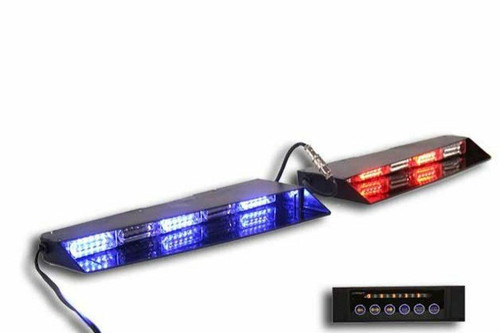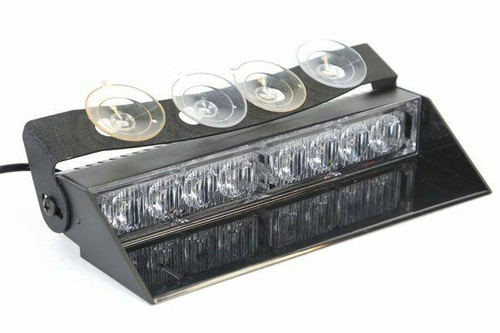Visor Light or Dash Light – Which is Better?
Posted by Extreme Tactical Dynamics on Jun 26th 2019
One of the most popular light types in our inventory is LED dash lights and visor lights. When shopping for emergency lighting, you’ll probably want to choose one of these units to add to your set-up. But, how do you know which one is right for your vehicle? Should you get them both? What are the advantages of having one over the other? Below, we will go over the pros and cons of each light type and then tell you which is better for certain situations.
Pros of Visor Lighting

- Mounts in the interior of a vehicle
- Virtually undetectable
- Comes with a flashback guard
- Takedowns are optional
- Sold with cigarette lighter plug and controller
- Delivers 24 to 90-watts of LED output on average
- Spreads across the entire windshield or rear windshield
- Easy to install with visor mount clips (may need some modification)
Cons Associated with this Light Type
- Expensive
- Mounting options are limited
Dash Lights Pros

- Syncable
- Affordable
- Interior light
- Easy to install
- Mounted with suction cups
- Comes with a flashback guard
- Design allows you to get creative with installation
Cons of this Light Type
- Only about 10.5” long on average (shorter or larger models may be available)
A Comparison of Dash and Visor Lighting
Now that we’ve laid out the pros and cons of each LED light choice, it’s time to talk about which one is right for you. As you can see, visor and dash lighting have many similarities. Both feature LED technology, install on the interior, offer plug-n-play options, and install fast. The main difference between these light types is illumination, mounting options, discreetness, and price. For a more detailed understanding of the differences, we have gone into more detail below.
Visor Lighting Delivers More Output than Dash Units
Due to their bigger size, visor mounted lights produce more illumination than smaller alternatives. Even the longest dash unit won’t have as many LEDs as a visor unit. On average, visor lighting has 8 to 90 LEDs installed in it. Depending on what type of technology was used to create the unit, you could have anywhere from 24 to 90-watts of power coming from a pair of cheap emergency visor lights.
Since lights made to rest on the dash are smaller than a visor light bar, they will include fewer LEDs. On average a dash only unit is about 10.5” long. It is usually mounted in the center of a vehicle’s dash or deck. Lights designed for visor installation usually stretch the entire length of a windshield.
Dash Lighting Offer More Creative Mounting Options in a Set-Up
One reason to opt for a dash unit over a visor alternative is because the smaller LED light offers more creative mounting options. Due to its design, a visor light is installed on the interior of a vehicle in the front or rear windshield. Most installers mount this light type near the roofline, but it could be modified to rest on the dash or deck of an emergency vehicle too. However, that is where the creativity ends.
A dash light allows for more creative options. In addition to being mounted on the dash or deck of a vehicle, this LED light can also be installed near the roofline too. Since most of these lighting types are syncable, it’s possible to use more than one in the same set-up to make a vehicle more visible.
Visor Lights are more Discreet than Units Mounted on the Dash or Deck
If you want to mount emergency lighting that isn’t immediately recognized by civilians, you’ll want to choose an LED visor unit. When installed in an emergency vehicle, this interior led light bar type is almost unrecognizable. Many emergency lights in this category mount on the back of a vehicle’s pre-existing visor, which allows the visor to be flipped up when not in use. If a car or truck has tinted windows, a light on the dash may be hard to detect as well, but not as hard to recognize as a visor light.
Dash Lighting is Very Affordable
Lastly, it comes down to price. Dash lights are one of the most affordable lights in many online retailers’ catalogs. Visor lighting is one of the most expensive. If you are on a tight budget, opting for a dash mounted light may allow you to purchase surface mounts or hideaways to balance your set-up better. If you are permanently outfitting fleet vehicles for police, fire, or EMS, a visor mounted light is usually going to be a better option. However, if you are looking for an affordable emergency led light bar to help you get to calls and don’t need anything sophisticated or permanent, a dash unit is the way to go.
Who Should Use Which Light Type?
Over the years, we have spent a great deal of time with first responders, tow truck drivers, and many others that use emergency or led warning light bar equipment on their vehicles. Through our experience, we have created a list of different vehicles that usually benefit from certain light types. Keep in mind that this is just our opinion based on experience and there is always exceptions to the rule.
What Vehicles Should Use Dash Lights?
- Tow trucks
- Construction vehicles
- Security vehicles
- Vehicles used on an as needed basis
- Storm chasing vehicles
- Volunteer firefighter POVs
What Emergency Vehicles Should Use Visor Lights?
- Police vehicles
- Fire vehicles
- Tow trucks
- Ambulances
As you can see, there may be some overlap between who should and shouldn’t use a dash or visor light. In some instances, an emergency vehicle may have both. But, now you have a better idea of which one meets your particular needs.
If you have any questions about the lights mentioned here or any others in our online store, please feel free to contact us and we can provide you with more information.
Related Posts
- Can Civilians Use Police Flashing Lights?
- FIRST RESPONDERS AND KIDS at the HOLIDAY SEASON
- The Perfect Holiday Gift for your First Responder
- K9 Police Officers and their Dogs
- IACP 2017 is Just Around the Corner
- Hurricane Harvey: A Tribute to First Responders
Tow Truck Fails – Drivers that Should Have Called a Professional
 Facebook
Twitter
Google+
Instagram
YouTube
Facebook
Twitter
Google+
Instagram
YouTube

